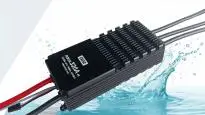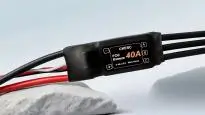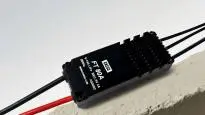I. Vertical Takeoff and Landing (VTOL) Motors for Drones: Core Principles
1. Mainstream Motor Type: Brushless DC Motor
Almost all suspended drones useExternal Rotor BLDCThe advantages are straightforward:
- No additional transmission required—the propeller rotates directly from the motor housing, delivering high torque and efficiency.
- Controlled by an electronic speed controller (ESC) with millisecond-level response, enabling precise attitude adjustments during vertical takeoff and landing.
2. 3 Essential Parameters You Must Know
- KV Value: No-load rotational speed per volt of voltage. Low KV values pair with large propellers, suitable for vertical takeoff and landing (high thrust); high KV values pair with small propellers, suitable for cruising (high speed).
- PowerContinuous power determines endurance; peak power must be ≥ hovering power × 1.5 (to accommodate takeoff and wind resistance).
- Efficiency Curve:Efficiency peaks at 60%-80% load; prioritize motor selection based on performance within this range.
3. Power Coordination for Takeoff, Landing, and Cruise
- Vertical takeoff and landing: All motors facing upward, requiring high thrust;
- Horizontal Cruise: Some motors rotate horizontally to provide thrust, while fixed wings generate lift. At this stage, motors should feature low KV and high efficiency.
II. Selecting a Drop-Down Motor: A 4-Step Implementation Guide
1. First, clearly define the three core requirements.
- Takeoff weightTotal weight (airframe + battery + payload) determines single-axis thrust.
- Range targetFor extended range, choose a “wide-efficiency-range motor” paired with a high-capacity battery.
- EnvironmentFor high-altitude environments, select motors optimized for elevated altitudes; For high-temperature/high-dust conditions, choose motors rated for 180°C temperature resistance with IP54 protection.
2. Propeller Matching
- Lowering phase: Large rotor diameter, low pitch, enhancing hover efficiency;
- Cruising phase: Small paddle diameter, high pitch, reduced wind resistance;
- Material: Professionals choose carbon fiber (lightweight, high strength); beginners opt for nylon (impact-resistant, affordable).
3. The motor and battery must be in sync.
- Voltage Matching: 12S battery (42-52V) corresponds to a 12S motor;
- Current matching: Motor continuous current ≤ Battery continuous discharge current.
4. Heat dissipation and protection must not be compromised.
- Heat dissipation: Opt for a “bottom air intake + front air exhaust” design;
- Protection: IP67 waterproof rating required for agricultural/marine applications; IP54 minimum for industrial inspection.
III. Pitfalls to Avoid + Maintenance: 2 Practical Tips
1. 3 Common Misconceptions
- Don't blindly chase high KV: High KV paired with large propellers can easily overload. Calculate KV based on propeller diameter.
- Don't overlook the efficiency curve: Choose motors with “high efficiency at 60%-80% load” for extended range.
- Don't skimp on battery costs: Only high-C-rate batteries can withstand the motor's peak current.
2. Simple maintenance
- Every 50 hours: Clean motor dust and inspect bearing wear.
- Battery: Store at 80% charge. Perform one deep charge-discharge cycle every 10 cycles.
IV. Future Trends
- Technology: Permanent magnet synchronous motors, distributed electric propulsion;
- Applications: City sightseeing, emergency rescue.




